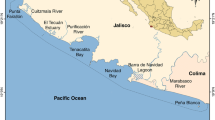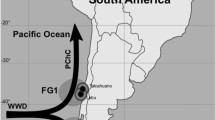Abstract
The feeding strategy of female yellowfin tuna (Thunnus albacares) during their reproductive cycle was investigated using a combination of different trophic tracers, i.e., stomach contents and dual stable isotope analysis, along with an assessment of ovarian development based on a histological analysis. To complete these analyses, we collected 215 female yellowfin from the Western Indian Ocean in 2009 and 2010. From these fish, we noted the ovarian development and analyzed the contents of 166 non-empty stomachs and 104 liver and muscle tissue samples. Stomach content analysis identified a large variety of prey species (45 prey families), key groups including crustaceans dominated by the swimming crab Charybdis smithii and crustacean larvae; fish dominated by the cigarfish Cubiceps pauciradiatus; and cephalopods dominated by ommastrephids Sthenoteuthis oualaniensis and Ornithoteuthis volatilis. Individuals capable of spawning appeared to feed intensively, particularly on cigarfish, during the reproductive period. From the mean reconstituted weight values of the preys, our results indicated that this intensive feeding led to increased amounts of acquired energy. The results of the stable isotope analyses, carried out on the muscle and liver tissues, indicated a clear decrease in values from north to south. These analyses also showed that liver δ15N values in spawning females were significantly lower than those in immature and developing individuals. This latter observation highlights the differences in metabolic processes that occur between tissues during ovarian development and underlines the importance of the liver in energy acquisition and mobilization in female yellowfin tuna during reproduction.



Similar content being viewed by others
References
Bard F, Kouamé B, Hervé A (2002) Schools of large yellowfin (Thunnus albacares) concentrated by foraging on a monospecific layer of Cubiceps pauciradiatus, observed in the eastern tropical Atlantic. ICCAT Coll Vol Sci Pap 54:33–41
Bodin N, Budzinski H, Le Ménach K, Tapie N (2009) ASE extraction method for simultaneous carbon and nitrogen stable isotope analysis in soft tissues of aquatic organisms. Anal Chim Acta 643:54–60
Clarke MR (1986) A handbook for the identification of cephalopod beaks. Clarendon Press, Oxford
Cortés E (1997) A critical review of methods of studying fish feeding based on analysis of stomach contents: application to elasmobranch fishes. Can J Fish Aquat Sci 54:726–738
Crosnier A, Forest J (1973) Les crevettes profondes de l’Atlantique oriental tropical. Faune Trop 19:1–409
Dagorn L, Holland KN, Itano DG (2007) Behavior of yellowfin (Thunnus albacares) and bigeye (T-obesus) tuna in a network of fish aggregating devices (FADs). Mar Biol 151:595–606
Davis RE (2005) Intermediate-depth circulation of the Indian and South Pacific Oceans measured by autonomous floats. J Phys Oceanogr 35:683–707
Dragovich A, Potthoff T (1972) Comparative study of food of skipjack and yellowfin tunas off the coast of West Africa. Fish Bull 70:1087–1110
Drent R, Daan S (1980) The prudent parent: energetic adjustments in avian breeding. Ardea 68:225–252
Flynn AJ, Paxton JR (2013) Spawning aggregation of the lanternfish Diaphus danae (family Myctophidae) in the north-western Coral Sea and associations with tuna aggregations. Mar Freshw Res 63:1255–1271
Fonteneau A, Lucas V, Tewkai E et al (2008) Mesoscale exploitation of a major tuna concentration in the Indian Ocean. Aquat Living Resour 21:109–121
Gislason H, Helgason T (1985) Species interaction in assessment of fish stocks with special application to the North Sea. Dana 5:1–44
Graham BS, Grubbs D, Holland K, Popp BN (2007) A rapid ontogenetic shift in the diet of juvenile yellowfin tuna from Hawaii. Mar Biol 150:647–658
Grande M (2013) The reproductive biology, condition and feeding ecology of the skipjack, Katsuwonus pelamis, in the Western Indian Ocean. Universidad del Pais Vasco, Leioa
Gruber N, Sarmiento JL (1997) Global patterns of marine nitrogen fixation and denitrification. Glob Biogeochem Cycles 11:235–266
Hallier JP, Gaertner D (2008) Drifting fish aggregation devices could act as an ecological trap for tropical tuna species. Mar Ecol Prog Ser 353:255–264
Hayashi K, Takagi T, Kondo H, Futawatari M (1978) The lipids of marine animals from various habitat depths. VII. Compositions of diacyl glyceryl ethers in the flesh lipids of two deep-sea teleost fish, Seriollela sp. and S. punctata. Jpn Soc Fish Sci 44:917–923
Hyslop EJ et al (1980) Stomach contents analysis-a review of methods and their application. J Fish Biol 17:411–429
IOTC (2012) Report of the fourteenth session of the IOTC working party on tropical tunas. Indian Ocean Tuna Comm, Mauritius
Itano (2001) The reproductive biology of yellowfin tuna (Thunnus albacares) in Hawaiian waters and the western tropical Pacific Ocean: project summary. University of Hawaii, Joint Institute for Marine and Atmospheric Research, Hawaii, p 69
Jaquemet S, Potier M, Ménard F (2011) Do drifting and anchored fish aggregating devices (FADs) similarly influence tuna feeding habits? A case study from the western Indian Ocean. Fish Res 107:283–290
Jennings S, van der Molen J (2015) Trophic levels of marine consumers from nitrogen stable isotope analysis: estimation and uncertainty. ICES J Mar Sci 72(8):2289–2300
Juan-Jordá MJ, Mosqueira I, Freire J, Dulvy NK (2013) Life in 3-D: life history strategies in tunas, mackerels and bonitos. Rev Fish Biol Fish 23:135–155
Kaplan DM, Chassot E, Amandé JM et al (2014) Spatial management of Indian Ocean tropical tuna fisheries: potential and perspectives. ICES J Mar Sci J Cons 71:1728–1749
Lobley GE (2003) Protein turnover—what does it mean for animal production? Can J Anim Sci 83:327–340
Lorrain A, Paulet Y-M, Chauvaud L et al (2002) Differential δ13 C and δ15 N signatures among scallop tissues: implications for ecology and physiology. J Exp Mar Biol Ecol 275:47–61. doi:10.1016/S0022-0981(02)00220-4
Madigan DJ, Litvin SY, Popp BN et al (2012) Tissue turnover rates and isotopic trophic discrimination factors in the endothermic teleost, Pacific Bluefin Tuna (Thunnus orientalis). PLoS One 7:e49220
Margulies D (2007) Spawning and early development of captive yellowfin tuna (Thunnus albacares). Fish Bull 105:249–265
Martínez del Rio C, Wolf N, Carleton SA, Gannes LZ (2009) Isotopic ecology ten years after a call for more laboratory experiments. Biol Rev 84:91–111. doi:10.1111/j.1469-185X.2008.00064.x
McBride RS, Somarakis S, Fitzhugh GR et al (2013) Energy acquisition and allocation to egg production in relation to fish reproductive strategies. Fish Fish. doi:10.1111/faf.12043
Ménard F, Labrune C, Shin YJ et al (2006) Opportunistic predation in tuna: a size-based approach. Mar Ecol Prog Ser 323:223–231
Ménard F, Lorrain A, Potier M, Marsac F (2007) Isotopic evidence of distinct feeding ecologies and movement patterns in two migratory predators (yellowfin tuna and swordfish) of the western Indian Ocean. Mar Biol 15357:141–152
Naqvi SWA, Naik H, Pratihary A et al (2006) Coastal versus open-ocean denitrification in the Arabian Sea. Biogeosciences 3:621–633
Nesis KN, Burgess LA, Levitov BS (1987) Cephalopods of the world: squids, cuttlefishes, octopuses, and allies. T.F.H. Publications Inc., Neptune City
Olson RJ, Boggs CH (1986) Apex predation by yellowfin tuna (Thunnus albacares)—independent estimates from gastric evacuation and stomach contents, bioenergetics, and cesium concentrations. Can J Fish Aquat Sci 43:1760–1775
Olson RJ, Popp BN, Graham BS et al (2010) Food-web inferences of stable isotope spatial patterns in copepods and yellowfin tuna in the pelagic eastern Pacific Ocean. Prog Oceanogr 86:124–138
Popp BN, Graham BS, Olson RJ, Hannides CCS et al (2007) Insight into the trophic ecology of yellowfin tuna, Thunnus albacares, from compound-specific nitrogen isotope analysis of proteinaceous amino acids. In: Dawson T, Siegwolf R (eds) Stable isotopes as indicators of ecological change. Elsevier Academic Press, Amsterdam, pp 173–190
Post DM (2002) Using stable isotopes to estimate trophic position: models, methods, and assumptions. Ecology 83:703–718
Potier M, Marsac F, Lucas R et al (2004) Feeding partitioning among tuna taken in surface and mid-water layers: the case of yellowfin (Thunnus albacares) and bigeye (T. obesus) in the Western Tropical Indian Ocean. West Indian Ocean J Mar Sci 3:51–62
Potier M, Marsac F, Cherel Y et al (2007) Forage fauna in the diet of three large pelagic fishes (lancetfish, swordfish and yellowfin tuna) in the western equatorial Indian Ocean. Fish Res 83:60–72
Potier M, Romanov E, Cherel Y et al (2008) Spatial distribution of Cubiceps pauciradiatus (Perciformes: Nomeidae) in the tropical Indian Ocean and its importance in the diet of large pelagic fishes. Aquat Living Resour 21:123–134
Potts G, Wootton R (1984) Fish Reproduction: Strategies and Tactics. Academic Press, London, p 1984
Roger C (1994) Relationships among yellowfin and skipjack tuna, their prey-fish and plankton in the tropical western Indian Ocean. Fish Oceanogr 3:133–141
Romanov E, Potier M, Zamorov V, Ménard F (2009) The swimming crab Charybdis smithii: distribution, biology and trophic role in the pelagic ecosystem of the western Indian Ocean. Mar Biol 156:1089–1107
Schaefer (1998) Reproductive biology of yellowfin tuna (Thunnus albacares) in the eastern Pacific Ocean. Inter-American Tropical Tuna Commmission 21
Schaefer KM, Fuller DW (2010) Vertical movements, behavior, and habitat of bigeye tuna (Thunnus obesus) in the equatorial eastern Pacific Ocean, ascertained from archival tag data. Mar Biol 157:2625–2642
Schmidt K, McClelland JW, Mente E et al (2004) Trophic-level interpretation based on δ15N values: implications of tissue-specific fractionation and amino acid composition. Mar Ecol Prog Ser 266:43–58
Schott FA, Dengler M, Schoenefeldt R (2002) The shallow overturning circulation of the Indian Ocean. Prog Oceanogr 53:57–103
Schott FA, Xie SP, McCreary JP (2009) Indian ocean circulation and climate variability. Rev Geophys 47:1–31. doi:10.1029/2007RG000245
Smale MJ, Watson G, Hecht T (1995) Otolith atlas of southern African marine fishes. Ichthyological monographs. J/L/B/Smith Institute of Ichthyology, Grahamstown
Smith MM, Heemstra PC (1986) Smith’s sea fishes. Macmillan, Johannesburg
Stearns S (1992) The evolution of life histories. Oxford University Press, New York
Tieszen LL, Boutton TW, Tesdahl KG, Slade NA (1983) Fractionation and turnover of stable carbon isotopes in animal tissues: implications for δ13C analysis of diet. Oecologia 57:32–37
Tregouboff G, Rose M (1978) Manuel de Planctonologie Méditerranéenne. CNRS, Paris
Vipin PM, Ravi R, Jose Fernandez T et al (2012) Distribution of myctophid resources in the Indian Ocean. Rev Fish Biol Fish 22:423–436. doi:10.1007/s11160-011-9244-4
Wieggert JD, Murtugudde RG, Christian JR (2006) Annual ecosytem variability in the tropical Indian Ocean: results of a couples bio-physical ocean general circulation model. Deep Sea Res 53:644–676
Wootton R (1998) Ecology of teleost fishes. Springer, New York
Zudaire I, Murua H, Grande M et al (2013a) Fecundity regulation strategy of the yellowfin tuna (Thunnus albacares) in the Western Indian Ocean. Fish Res 138:80–88
Zudaire I, Murua H, Grande M, Bodin N (2013b) Reproductive potential of Yellowfin Tuna (Thunnus albacares) in the western Indian Ocean. Fish Bull 111:252–264
Zudaire I, Murua H, Grande M et al (2014) Accumulation and mobilization of lipids in relation to reproduction of yellowfin tuna (Thunnus albacares) in the Western Indian Ocean. Fish Res 160:50–59
Acknowledgments
We thank Dr. Y. Cherel for his assistance in identifying cephalopod species using small-sized beaks, X. Salaberria for his help in processing the samples, and J. Murua, G. Ocio, and A. Sanchez for the onboard collection of the samples. We also thank Dr. J.Alpine for her great professional proof reading service. This research benefited from the financial support of the Department of Agriculture, Fisheries and Food of the Basque Government, and the Pesquería Vasco Montañesa S.A. (PEVASA) fishing company. This work was partly funded by a Ph.D. grant of I. Zudaire Balerdi from the Fundación Centros Tecnológicos Iñaki Goenaga and Basque Government Postdoctoral grant. We are also grateful for the contribution received from the EMOTION Project (ANR JSV7 007 01). The experiments complied with the current laws of the countries in which they were performed. The authors declare that they have no conflicts of interest. This paper is contribution nº 734 from AZTI (Marine Research Department).
Author information
Authors and Affiliations
Corresponding author
Additional information
Responsible Editor: C. Harrod.
Reviewed by A. Teffer and an undisclosed expert.
Rights and permissions
About this article
Cite this article
Zudaire, I., Murua, H., Grande, M. et al. Variations in the diet and stable isotope ratios during the ovarian development of female yellowfin tuna (Thunnus albacares) in the Western Indian Ocean. Mar Biol 162, 2363–2377 (2015). https://doi.org/10.1007/s00227-015-2763-0
Received:
Accepted:
Published:
Issue Date:
DOI: https://doi.org/10.1007/s00227-015-2763-0




